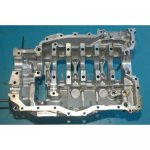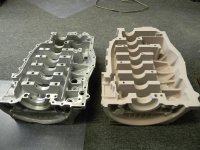Hello,
I am new here. My company is beginning to make reproduction Porsche 911 engine cases, and the way we are doing it is by having the foundry make the casting (A356T56), then using our Haas UMC 1000 to machine the features within the case halves. We have this part pretty much figured out.
What the problem is, or the part we can't wrap our heads around is how to properly ream/bore/drill the main journals and layshaft accurately.
The way this SHOULD be done is to bolt both the case halves together and align bore both the mains and the layshaft. This part we know. HOWEVER, what would be the best machine to do this with? Specs are as follows:
Main journal bore: 65.000-65.0019mm - approximately 20.5" long
Layshaft bore: 27.500-27.521 - approximately 20.5" long
No one has built a new case in decades, and the knowledge of how to do this seems lost. In the aftermarket, when repairing an old case, usually all that is needed is a line hone. In this case, we have to establish the initial rough bore with the UMC 1000, and then create a finished bore.
I was thinking a Jig Bore would be best for this, but I haven't yet seen one that has 20.5" of Y axis travel yet.
We need these two parallel bores to be ultra accurate, but the good news is, once we set up and fixture this operation, we will be able to do it over and over again. We are only making the one case.


 (NOT MINE), of someone on this forum doing a repair operation on a used case that gives an idea of what we are looking at.
(NOT MINE), of someone on this forum doing a repair operation on a used case that gives an idea of what we are looking at.
Thanks for your help!!!!
I am new here. My company is beginning to make reproduction Porsche 911 engine cases, and the way we are doing it is by having the foundry make the casting (A356T56), then using our Haas UMC 1000 to machine the features within the case halves. We have this part pretty much figured out.
What the problem is, or the part we can't wrap our heads around is how to properly ream/bore/drill the main journals and layshaft accurately.
The way this SHOULD be done is to bolt both the case halves together and align bore both the mains and the layshaft. This part we know. HOWEVER, what would be the best machine to do this with? Specs are as follows:
Main journal bore: 65.000-65.0019mm - approximately 20.5" long
Layshaft bore: 27.500-27.521 - approximately 20.5" long
No one has built a new case in decades, and the knowledge of how to do this seems lost. In the aftermarket, when repairing an old case, usually all that is needed is a line hone. In this case, we have to establish the initial rough bore with the UMC 1000, and then create a finished bore.
I was thinking a Jig Bore would be best for this, but I haven't yet seen one that has 20.5" of Y axis travel yet.
We need these two parallel bores to be ultra accurate, but the good news is, once we set up and fixture this operation, we will be able to do it over and over again. We are only making the one case.


 (NOT MINE), of someone on this forum doing a repair operation on a used case that gives an idea of what we are looking at.
(NOT MINE), of someone on this forum doing a repair operation on a used case that gives an idea of what we are looking at. Thanks for your help!!!!





